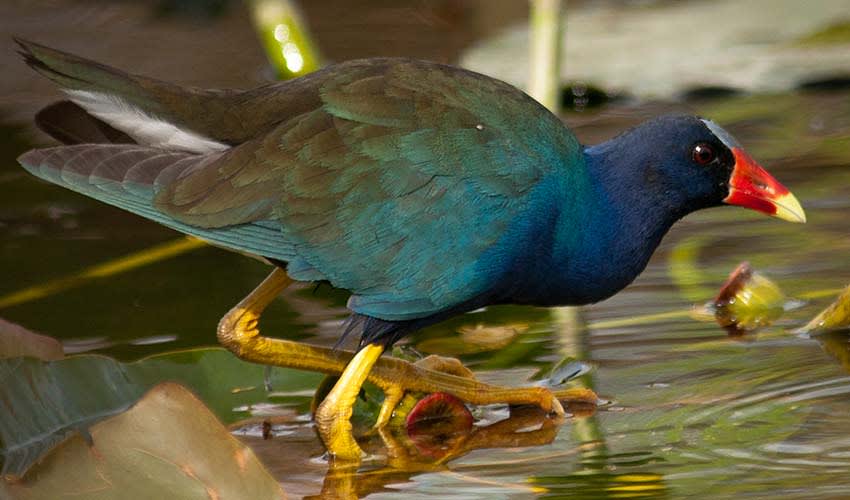Found in marshes, wetlands, and freshwater ponds from the southeastern United States down through Central and South America, it stands out immediately for its brilliant colors. Adults sport shimmering plumage that glows with iridescent shades of purple, turquoise, and green, paired with a bright red-and-yellow bill and long yellow legs. In the sunlight, their feathers gleam like polished metal, making them one of the most striking birds of their habitats. Despite their beauty, they are surprisingly well adapted to the challenges of marshy life.
With long toes that spread their weight across wide surfaces, these birds can literally walk on lily pads without sinking, giving them a graceful, almost magical appearance. They use this skill to forage for seeds, berries, insects, small fish, frogs, and even the tender parts of aquatic plants. Their diet is unusually varied, making them opportunistic feeders. Unlike ducks, they don’t dabble in open water as much as they pick and probe through the floating gardens of their marshland homes. Their ability to straddle plants, clamber through reeds, and even climb low shrubs with their oversized toes makes them some of the most versatile foragers in wetland ecosystems.
While many wetland birds are shy, gallinules are often seen fearlessly strutting across lily pads or along the edges of ponds, showing off their radiant plumage. They are also strong flyers for a marsh bird and have been recorded as long-distance wanderers, sometimes turning up far outside their normal range—in places as surprising as Canada, Europe, and even South Africa!
Distribution
 Antigua & Barbuda
Antigua & Barbuda Argentina
Argentina Aruba
Aruba Bahamas
Bahamas Barbados
Barbados Belize
Belize Bermuda
Bermuda Bolivia
Bolivia Brazil
Brazil British Virgin Is.
British Virgin Is. Canada
Canada Cayman Islands
Cayman Islands Chile
Chile Colombia
Colombia Costa Rica
Costa Rica Cuba
Cuba Dominica
Dominica Dominican Republic
Dominican Republic Ecuador
Ecuador El Salvador
El Salvador Falkland Islands
Falkland Islands French Guiana
French Guiana Guadeloupe
Guadeloupe Guatemala
Guatemala Guyana
Guyana Haiti
Haiti Honduras
Honduras Iceland
Iceland Jamaica
Jamaica Martinique
Martinique Mexico
Mexico Montserrat
Montserrat Nicaragua
Nicaragua Panama
Panama Paraguay
Paraguay Peru
Peru Portugal
Portugal Puerto Rico
Puerto Rico Saint Barthélemy
Saint Barthélemy Saint Lucia
Saint Lucia Saint Pierre
Saint Pierre Saint Vincent
Saint Vincent St. Kitts & Nevis
St. Kitts & Nevis Suriname
Suriname Trinidad & Tobago
Trinidad & Tobago Turks & Caicos
Turks & Caicos US Virgin Islands
US Virgin Islands United Kingdom
United Kingdom United States
United States Uruguay
Uruguay Venezuela
VenezuelaAnything we've missed?
Help us improve this page by suggesting edits. Glory never dies!
Suggest an editGet to know me
Terrestrial / Aquatic
Altricial / Precocial
Polygamous / Monogamous
Dimorphic (size) / Monomorphic
Active: Diurnal / Nocturnal
Social behavior: Solitary / Pack / Herd
Diet: Carnivore / Herbivore / Omnivore / Piscivorous / Insectivore
Migratory: Yes / No
Domesticated: Yes / No
Dangerous: Yes / No




